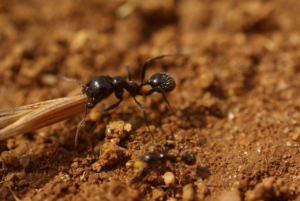This article was published in Biological Conservation.

It is part of Tania de Almeida‘s PhD. It highlights the engineer’s role of the Messor barbarus harvester ant on Mediterranean dry grasslands and its impact on the Crau steppe being restored.
M. barbarus improves soil fertility and leads to a significant increase in biomass. It modifies the seed bank by making it evolve in the direction of the reference steppe. It contributes to the heterogeneity of plant communities and the increase in species richness. Within ant nests, the species are more characteristic of mesotrophic environments, whereas outside the nest, the species are more characteristic of compact soils . M. barbarus is accelerating the restoration of the Crau steppe.
Tania De Almeida is a PdD student at the Mediterranean Institute of marine and terrestrial Biodiversity and Ecology (IMBE) co-supervised by the Tour du Valat (read more).
Tania PhD subject is : Restoration: using ants as ecosystem engineers to restore degraded areas in Provence, as part of the Tour du Valat’s activities on ecological restoration (read more).
You can access to this article on the publisher’s website.
Abstract:
Although not widely used, ecosystem engineers represent a promising and sustainable tool in nature-based ecosystem management and restoration. In grassland ecosystems, a few invertebrates that engineer soils have been identified as key species regulating soil nutrients and plant communities’ diversity and dynamics. Here, we assessed the role of the harvester ant Messor barbarus, an ecological engineer, in a Mediterranean dry grassland under restoration by characterising its nest environment, particularly the soil and vegetation. We found profound differences in soil physical and chemical variables and plant community structure between nests and ant-free patches in the restored grassland. Messor barbarus has improved soil fertility, driven the seed bank towards the reference grassland and significantly increased plant biomass, species richness and micro-local-heterogeneity. As biological filters, M. barbarus has driven plant communities towards a new trajectory in the restored site. Ant patches are characterised by mesotrophic species, whereas ant-free patches are dominated by species characteristic of compacted soils. They have accelerated the ecological recovery of Mediterranean dry grassland plants by directly and indirectly facilitating their re-establishment. These results illustrate the potential key role of ants as ecological engineers for the conservation and restoration of Mediterranean grasslands.
Bibliographical reference : De Almeida. T., Blight, O., F. Mesléard, A. Bulot, E. Provost and T. Dutoit. 2020. Harvester ants as ecological engineers for Mediterranean grassland restoration: Impacts on soil and vegetation. Biological Conservation 245 (2020). doi: 10.1016/j.biocon.2020.108547